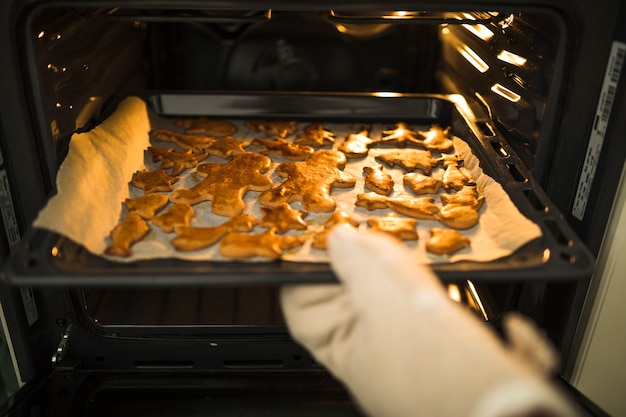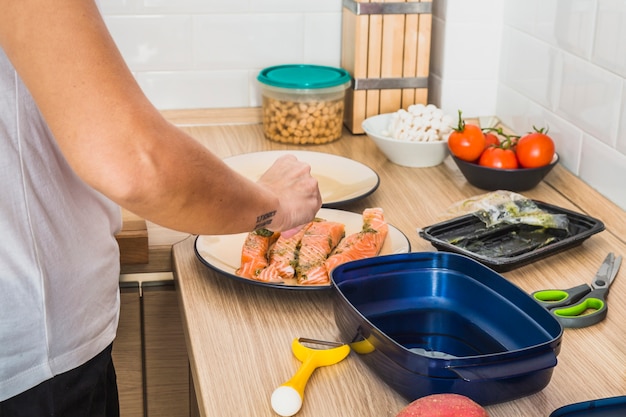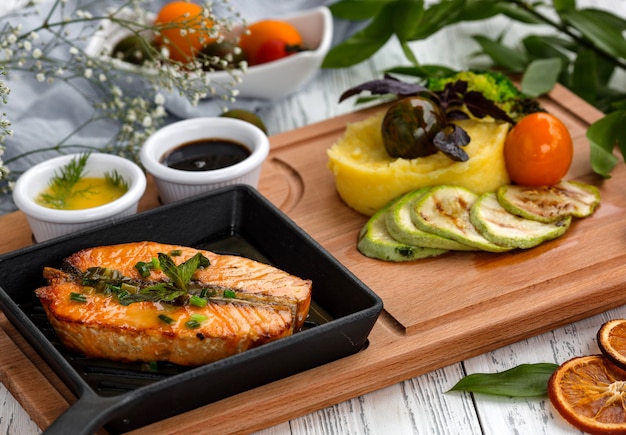As a seasoned cook, I've spent years perfecting my salmon baking skills. There's nothing quite like the juicy, flaky texture and the delicious flavour of a perfectly cooked salmon fillet. But finding that sweet spot, where the salmon is cooked through but not overdone, can be tricky.
I've learned that it's not just about the bake time, it's about understanding how salmon cooks and how to choose the right oven temperature. It's also about being patient and checking for doneness frequently. With these tips, you can create salmon that's a culinary masterpiece every time.
(Part 1) Understanding Salmon and Its Cook Time

The key to baking salmon to perfection is understanding the unique way it cooks. Unlike chicken or beef, where you're looking for a specific internal temperature, salmon's doneness is judged by its texture and appearance. We're aiming for a state where the fish is cooked through, but still juicy and tender.
How Salmon Cooks: A Visual Guide
To understand how to bake salmon, it's helpful to visualize the different stages of its cooking process. Here's what you should look for:
- Raw: The salmon is bright red and translucent, with a soft, springy texture.
- Slightly cooked: The edges of the salmon will begin to turn opaque, and the colour will slightly darken. The center will still be translucent, but the flesh will feel firmer and more resilient to pressure.
- Medium-rare: The salmon will be cooked through, but the center will still be slightly translucent. The flesh will be tender and flaky, with a soft but yielding texture.
- Medium: The entire salmon will be opaque, with a slightly firm texture. The flesh will flake easily, but it will have lost some of its initial tenderness.
- Well-done: The salmon will be opaque and dry, with a firm texture. The flesh will flake readily, but it will have a dry, rubbery texture. This is often overcooked, and you'll want to avoid this.
The Importance of Thickness
The thickness of your salmon fillets is crucial when determining baking time. Thicker fillets will take longer to cook through than thinner ones. The heat needs to travel further through a thicker piece of fish, requiring a longer cooking time to ensure even doneness.
Here's a quick guide to salmon thickness and their respective bake times:
| Salmon Thickness | Bake Time |
|---|---|
| 1/2 inch (1.25 cm) | 10-12 minutes |
| 3/4 inch (1.9 cm) | 12-15 minutes |
| 1 inch (2.5 cm) | 15-20 minutes |
These are just estimates, and it's always best to check the salmon's doneness with a fork or a meat thermometer.
(Part 2) The Right Oven Temperature for perfect salmon

The oven temperature is just as important as the bake time. Many people believe that a high oven temperature will cook salmon faster. But a lower temperature is actually the key to achieving juicy, flavorful salmon.
Why Lower Temperatures Are Better
A lower oven temperature allows the salmon to cook gently and evenly, preventing the exterior from overcooking before the center reaches the desired doneness. Think of it like baking a cake – you wouldn't bake it at a high temperature, would you? You want to cook it slowly and evenly to achieve a moist and tender texture.
The Perfect Oven Temperature for Salmon
I recommend baking salmon at 350°F (175°C). This temperature is gentle enough to cook the salmon through without drying it out, ensuring that the fish is cooked evenly throughout.
(Part 3) The Baking Process: Setting Up for Success

Now that you understand the basics of salmon baking, it's time to prepare your fish for the oven. Here are some helpful tips for prepping and baking salmon to perfection.
Preparing Your Salmon
Before you pop the salmon in the oven, take a few minutes to make sure it's seasoned and ready to bake:
- Pat it dry: Remove any excess moisture from the salmon using paper towels. This will help the skin crisp up and prevent the salmon from steaming in the oven, which can lead to a soggy texture.
- Season it well: Salt and pepper are classic seasonings for salmon, but don't be afraid to experiment with other spices, such as garlic powder, paprika, or lemon zest. The spices will infuse the fish with flavor and help it cook evenly.
- Add some fat: A drizzle of olive oil or melted butter will help the salmon stay moist and prevent it from sticking to the baking sheet. It also adds a lovely richness to the fish.
Baking the Salmon: The Essential Steps
Now, onto the baking process itself:
- Preheat your oven: Always preheat your oven to the desired temperature, in this case, 350°F (175°C). This ensures that the salmon cooks evenly and reaches the right internal temperature.
- Line your baking sheet: Place a sheet of parchment paper or foil on your baking sheet. This will prevent the salmon from sticking and make cleanup a breeze.
- Place the salmon on the baking sheet: Arrange your salmon fillets on the baking sheet in a single layer, ensuring that there's enough space between them for even cooking.
- Bake the salmon: Bake the salmon for the appropriate time based on its thickness. Refer to the guide we discussed earlier. If you're unsure, it's better to undercook the salmon slightly than overcook it.
- Check for doneness: To check if the salmon is done, gently press the flesh with a fork. If the flesh flakes easily and the center is no longer translucent, it's ready. You can also use a meat thermometer to check for an internal temperature of 145°F (63°C).
(Part 4) The Importance of Patience: Don't Overcook Your Salmon!
Patience is key when baking salmon. Don't rush the baking process! overcooked salmon is dry and tough, and it can ruin the entire dish. The goal is to cook the salmon just to the point where it's flaky and tender, with a juicy, moist texture.
If you're unsure about doneness, err on the side of caution and bake it for a shorter time. It's always easier to cook the salmon a bit longer than to try and salvage it if it's overcooked.
Signs of Overcooked Salmon
- Dry and tough texture: The flesh will be firm and difficult to flake with a fork. It will have a rubbery texture and may even feel a bit stringy.
- Opaque and pale color: Overcooked salmon will lose its vibrant pink or red hue and become a dull white or gray.
- Shrunken and curled edges: The edges of the salmon will curl up and become dry and crispy. This is a sure sign of overcooking.
How to Avoid Overcooking
The best way to avoid overcooked salmon is to check it for doneness frequently. I usually check the salmon about halfway through the recommended baking time. You can also use a meat thermometer to ensure the internal temperature is 145°F (63°C). If you see any signs of overcooking, remove the salmon from the oven immediately.
(Part 5) The Art of Salmon Presentation: A Culinary Symphony
A perfectly cooked salmon fillet deserves a beautiful presentation. After all, eating is a multi-sensory experience, and a visually appealing dish can enhance the entire dining experience.
Balancing Flavors and Textures
Think about the flavors and textures you want to incorporate. While a simple baked salmon is delicious, you can easily elevate it to a more sophisticated dish by adding complementary flavors and textures.
Here are a few ideas to inspire you:
- A citrusy touch: A squeeze of lemon or lime juice adds a bright and refreshing flavor that cuts through the richness of the salmon.
- The power of herbs: Fresh herbs like dill, parsley, or chives add a fragrant and aromatic touch that complements the salmon's flavor.
- Creamy accompaniments: A dollop of sour cream, crème fra??che, or pesto creates a delicious and creamy counterpoint to the salmon's flaky texture.
- Roasted vegetables: Roast some broccoli, asparagus, or bell peppers to add some color and texture to your dish. The roasted vegetables will also absorb the flavors from the salmon, creating a symphony of deliciousness.
A Touch of Elegance
Presentation is everything, so don't just plunk the salmon on a plate and call it a day. Think about how you can make it look more inviting and elegant:
- Use a beautiful serving platter: A simple white platter allows the vibrant salmon to shine, while a wooden serving board adds a rustic charm.
- Garnish with finesse: A sprig of fresh herbs, a lemon wedge, or a few edible flowers can make the dish feel special.
- Create a visual contrast: Arrange the salmon on the plate with contrasting colors. For example, serve it with green asparagus and yellow bell peppers, or use a vibrant red pepper to create a visually appealing contrast.
(Part 6) salmon recipes: Beyond the Basics
Let's move beyond the basic baked salmon and explore some delicious variations that will take your salmon game to the next level.
salmon with lemon and Dill
This classic combination is a winner! The bright flavors of lemon and dill complement the rich taste of salmon beautifully.
Ingredients
- 1 pound salmon fillets
- 1 tablespoon olive oil
- 1 lemon, thinly sliced
- 1/4 cup fresh dill, chopped
- Salt and pepper to taste
Instructions
- Preheat oven to 350°F (175°C).
- Line a baking sheet with parchment paper.
- Place the salmon fillets on the baking sheet.
- Drizzle the salmon with olive oil.
- Top each fillet with a few lemon slices and a sprinkle of dill.
- Season with salt and pepper.
- Bake for 12-15 minutes, or until the salmon is cooked through.
Salmon with Roasted Vegetables
This is a hearty and healthy meal option that's perfect for a weeknight dinner. The roasted vegetables will soak up the juices from the salmon, creating a delicious and satisfying meal.
Ingredients
- 1 pound salmon fillets
- 1 tablespoon olive oil
- 1 cup broccoli florets
- 1 cup Brussels sprouts, halved
- 1/2 cup cherry tomatoes
- Salt and pepper to taste
Instructions
- Preheat oven to 400°F (200°C).
- Line a baking sheet with parchment paper.
- Toss the broccoli, Brussels sprouts, and cherry tomatoes with olive oil, salt, and pepper.
- Spread the vegetables on the baking sheet in a single layer.
- Place the salmon fillets on top of the vegetables.
- Roast for 15-20 minutes, or until the salmon is cooked through and the vegetables are tender.
Salmon En Croute
This is a fancier option that's perfect for special occasions. The flaky puff pastry provides a beautiful and elegant shell for the salmon, and the combination of flavors is sure to impress your guests.
Ingredients
- 1 pound salmon fillets
- 1 tablespoon olive oil
- 1/4 cup fresh herbs (dill, parsley, thyme)
- Salt and pepper to taste
- 1 sheet of puff pastry, thawed
- 1 egg, beaten
Instructions
- Preheat oven to 400°F (200°C).
- Line a baking sheet with parchment paper.
- Place the salmon fillets on the baking sheet.
- Drizzle the salmon with olive oil.
- Sprinkle the salmon with herbs, salt, and pepper.
- Roll out the puff pastry on a lightly floured surface to a rectangle that's slightly larger than the salmon fillets.
- Place the salmon fillets in the center of the pastry.
- Fold the pastry over the salmon fillets to enclose them completely.
- Brush the top of the pastry with the beaten egg.
- Bake for 20-25 minutes, or until the pastry is golden brown and the salmon is cooked through.
(Part 7) Storing Your Salmon: Keeping it Fresh
If you've got leftovers, store them properly to prevent them from drying out and losing their flavor.
Here's what I do:
- Refrigerate it properly: Store leftover salmon in an airtight container in the refrigerator.
- Avoid moisture: Avoid storing the salmon directly on the plate. It will absorb moisture and become soggy. Use an airtight container or wrap the salmon tightly in plastic wrap.
- Use within 2-3 days: Salmon is best eaten within 2-3 days of cooking. After that, it starts to lose its flavor and texture.
(Part 8) FAQs: Your Salmon Baking Questions Answered
Here are a few frequently asked questions about baking salmon:
1. What if I don't have a meat thermometer?
No worries, a meat thermometer is helpful but not essential. To check if your salmon is cooked through, gently press the flesh with a fork. If the flesh flakes easily and the center is no longer translucent, it's ready.
2. Can I bake salmon with the skin on?
Absolutely! Baking salmon with the skin on helps to keep it moist and flavorful. It also makes it easier to handle and prevents the fish from breaking apart during cooking. The skin will crisp up nicely in the oven.
3. What if I overcook the salmon?
If you accidentally overcook your salmon, don't despair! It may be a bit dry, but it's still edible. You can try to salvage it by adding a bit of moisture and flavor. For example, you can top the salmon with a sauce, like a lemon dill sauce or a creamy herb sauce.
4. Can I freeze salmon after baking?
Yes, you can freeze baked salmon, but it's best to freeze it before cooking. This will help to preserve its flavor and texture. frozen salmon can be thawed in the refrigerator overnight and then reheated in the oven.
5. Is it better to bake salmon skin-side down or skin-side up?
It really depends on your preference. If you prefer a crispy skin, bake the salmon skin-side up. The skin will get crispy and golden brown in the oven. If you prefer a more tender skin, bake it skin-side down. The skin will be more tender and less crispy, but it will still be delicious.
Now, get out there and bake some delicious salmon! Remember, it's all about understanding the fundamentals, practicing patience, and having fun in the kitchen!
Everyone is watching

How to Cook Frozen Lobster Tails Perfectly: A Step-by-Step Guide
RecipesLobster. Just the word conjures up images of lavish meals, special occasions, and a taste of luxury. But let's...

Pigs in a Blanket Cooking Time: How Long to Bake for Perfect Results
RecipesAh, pigs in a blanket. Just the name conjures up images of those delightful little parcels of crispy pastry en...

Pork Fillet Cooking Time: How Long to Cook It Perfectly
RecipesPork fillet, or tenderloin as it's sometimes called, is a real favourite in our house. It's so versatile, and...

The Ultimate Guide to Cooking Delicious Frankfurters
RecipesLet's face it, we all love a good frankfurter. It's a classic, simple, and always satisfying. But let's be rea...

The Ultimate Guide to Tender, Juicy Pulled Pork
RecipesRight, let's talk pulled pork. It's one of those dishes that just screams "comfort food," doesn't it? I mean...
